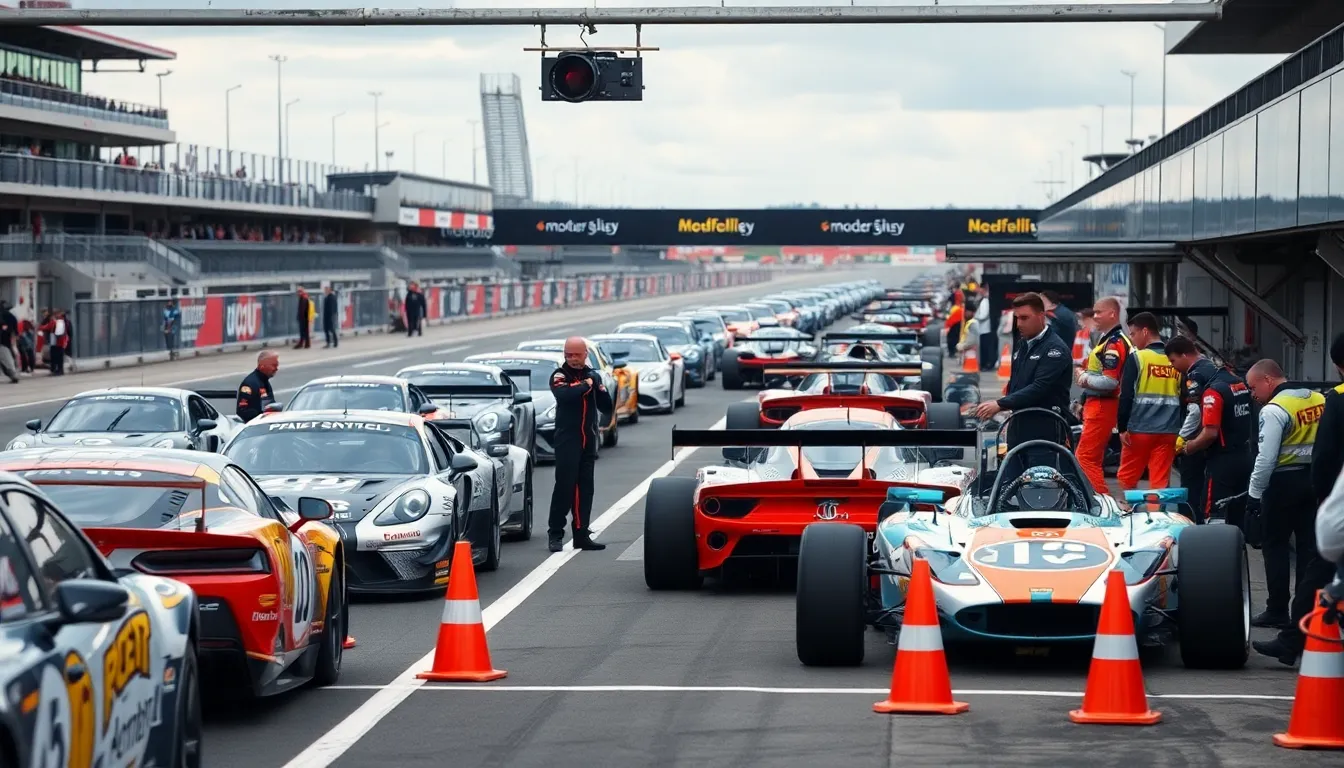Table of Contents
ToggleWhen the rubber meets the road, every second counts, especially in the high-octane world of motorsports. But what happens when a driver approaches the pit lane? Enter the pit lane entry rules, the unsung heroes of racing that dictate how teams can dash for a quick tire change or a splash of fuel. Think of them as the traffic lights of the racetrack—without them, it’d be chaos, and nobody wants to see a pit crew doing the cha-cha in the middle of a race.
Overview of Pit Lane Entry Rules
Pit lane entry rules govern how drivers access the pit area during races. These regulations ensure that drivers enter the pit lane safely and efficiently while minimizing risks. Following these rules protects both the competitors and the pit crews, allowing for a streamlined process during key moments.
Drivers must adhere to specific speed limits when entering the pit lane. Speed limits typically range from 37 to 60 kilometers per hour (23 to 37 miles per hour) depending on the circuit. Exceeding this limit can result in penalties, emphasizing the importance of caution in the high-pressure environment.
Signage and cones guide racers in the pit area. Stripes marked on the asphalt indicate the boundary between the race track and the pit entry. Additionally, mandatory lanes help maintain order and prevent potential collisions.
When approaching the pit lane, drivers must signal their intent to pit. This action increases visibility for other competitors, promoting awareness in a busy environment. Equally crucial is the need to align with the correct pit box after entering. Each team occupies a designated space, which facilitates quick tire changes and refueling operations.
Conditions within the pit lane often change rapidly. Rain, for example, can affect tire choices, requiring quick decisions from drivers and teams alike. Awareness of changing conditions also helps maintain safety during pit stops.
Respecting these rules leads to smoother pit operations. Decision-making becomes more efficient, and risks associated with accidents diminish. Following pit lane entry rules ultimately contributes to fair competition and the well-being of all participants.
Importance of Pit Lane Entry Rules

Pit lane entry rules maintain safety and order in motorsports during high-pressure situations.
Safety Considerations
Safety remains a primary concern in the pit lane. Drivers must follow designated speed limits, typically between 37 and 60 kilometers per hour (23 to 37 miles per hour). Exceeding these limits results in penalties, promoting a controlled environment. Signage and cones strategically placed enhance visibility and guide drivers safely. Signaling intent to pit increases awareness among crew members and competitors, reducing the risk of collisions. The dynamic nature of pit stops requires teams to react swiftly. Compliance with these rules creates a safer working atmosphere for both drivers and pit crews.
Impact on Race Strategy
Race strategies often hinge on effective pit lane management. Drivers coordinate their pit entries to align with overall race plans. Efficient entries can save crucial seconds during tire changes or refueling. Teams analyze track conditions and competitor behaviors to determine the optimal moment to pit. Knowing when to enter the pit lane can provide a tactical advantage. Real-time decision-making allows teams to adapt strategies based on race developments. Successful navigation of pit lane rules enables smoother transitions, ultimately influencing race outcomes and enhancing competitive fairness.
Key Pit Lane Entry Rules
Pit lane entry rules encompass essential guidelines that contribute to safety and order during races. Adherence to these regulations ensures both drivers and pit crews operate in a secure environment.
Speed Limits
Drivers must observe specific speed limits when entering the pit lane, typically ranging from 37 to 60 kilometers per hour or 23 to 37 miles per hour. Exceeding these limits incurs penalties that can affect race standings. Speed limits remain crucial for maintaining control in the confined area, allowing teams to perform necessary tasks without unnecessary risk. Precise adherence to these limits promotes a safer atmosphere for everyone involved in pit operations.
Vehicle Control
Maintaining vehicle control becomes vital during pit lane entry. Drivers must manage their speed while navigating the often-congested space, ensuring a smooth approach to the pit box. Proper braking techniques play a significant role in minimizing risk as vehicles slow down for pit stops. Additionally, quick decision-making is necessary to respond to dynamic conditions in the pit lane, helping drivers position their vehicles accurately. Skilled vehicle control supports the efficiency of the pit crew, leading to faster service times and improved performance.
Signage and Markings
Clear signage and markings guide drivers through the pit lane. Various indicators inform racers of speed limits, designated pit boxes, and lane boundaries. Cones and lines ensure drivers navigate safely, reducing the likelihood of accidents. Visibility plays a crucial role; therefore, drivers must stay alert and heed the displayed instructions. Following these visual cues enhances safety and streamlines pit operations, making successful navigation essential for any competitive race.
Common Violations and Penalties
Understanding common violations in pit lane entry can help drivers avoid penalties. These violations disrupt the orderly functioning of the pit area and compromise safety.
Types of Violations
Speeding constitutes a frequent violation, as drivers often exceed the designated limits of 37 to 60 kilometers per hour (23 to 37 miles per hour). Failing to signal intent to pit creates confusion among other drivers, especially in high-pressure situations. Incorrect alignment of the vehicle with the designated pit box also occurs, leading to delays. Running over cones or crossing lane boundaries further complicates the situation. Each of these actions contributes to an unsafe environment and can lead to significant consequences.
Consequences for Drivers
Penalties vary based on the severity of the violation. Speeding results in a time penalty or possible fines. Ignoring signaling rules may lead to warnings or fines, increasing a driver’s risk of further penalties. Misalignment during pit stops can compel teams to waste valuable seconds correcting the vehicle’s position. Drivers might face stricter rulings for repeated offenses, including potential disqualification from the race. Upholding safety and adherence to rules remains essential in maintaining a fair competition.
Pit lane entry rules are essential for maintaining safety and efficiency in motorsports. By enforcing speed limits and proper signaling, these regulations help prevent chaos during critical pit stops. Drivers must remain vigilant and adhere to these guidelines to ensure not only their safety but also that of their pit crews.
The impact of effective pit lane management extends beyond safety; it plays a significant role in race strategy and overall performance. Teams that navigate these rules successfully can save valuable seconds and enhance their competitive edge. Ultimately, a commitment to following pit lane entry rules fosters a fair and orderly racing environment, benefiting everyone involved in the sport.




